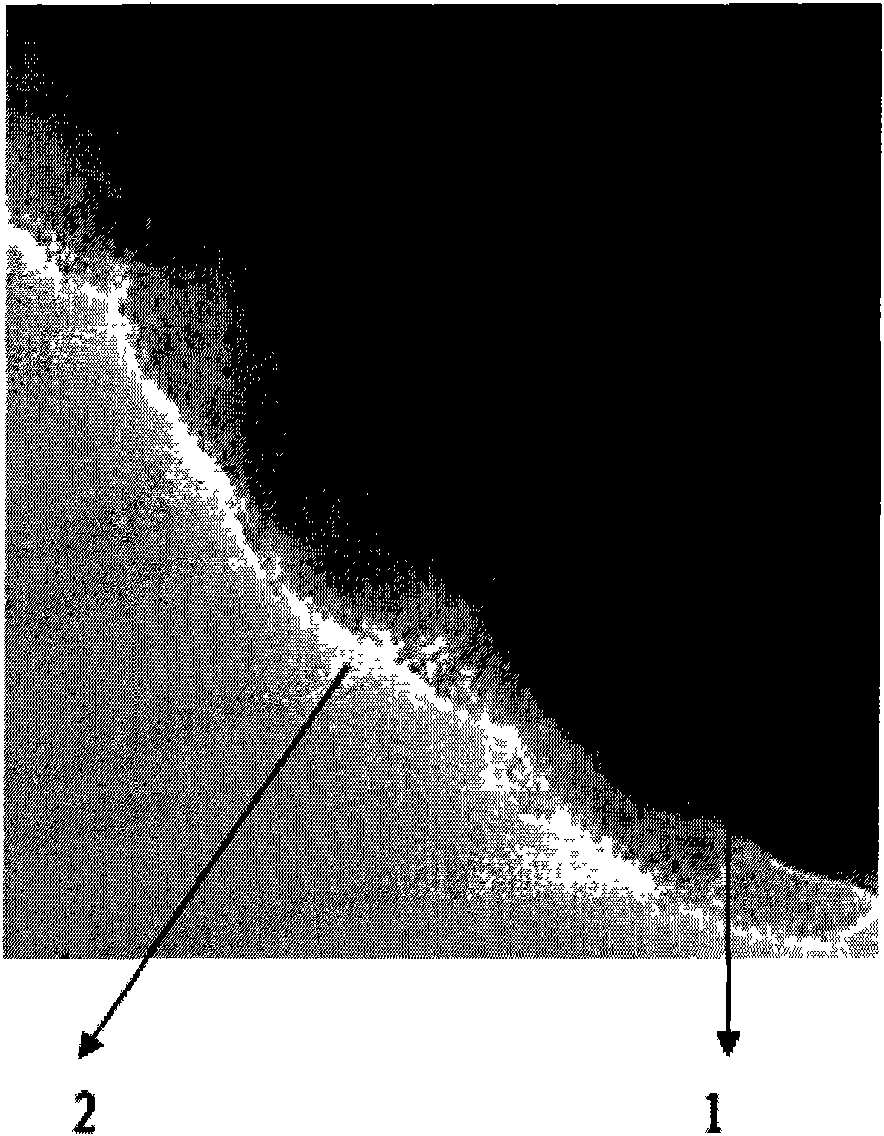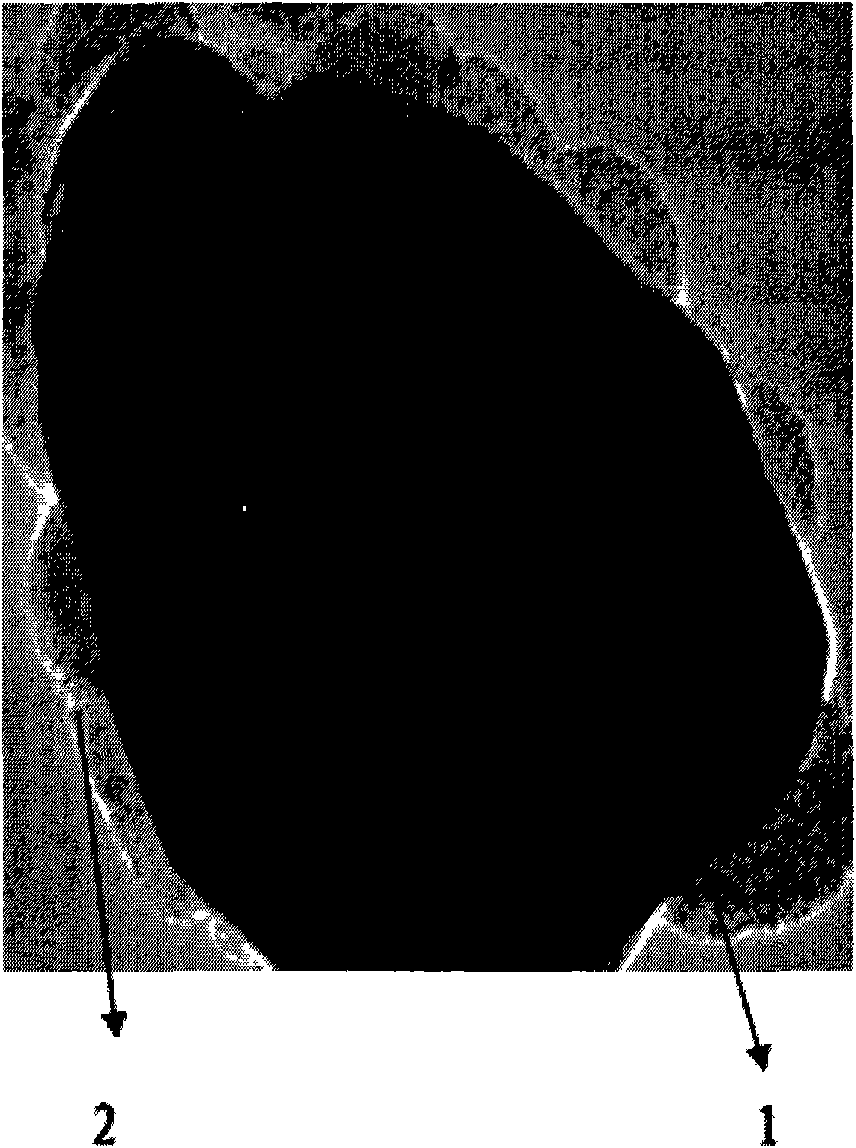Method for preparing photocatalyst with core-shell structure
A technology of core-shell structure and photocatalyst, which is applied in chemical instruments and methods, catalyst activation/preparation, physical/chemical process catalysts, etc., can solve the problems of cumbersome preparation process, high energy consumption, large nano-titanium dioxide grains, etc., and achieve the goal of preparing The effect of simple process, high catalytic activity and large specific surface area
- Summary
- Abstract
- Description
- Claims
- Application Information
AI Technical Summary
Problems solved by technology
Method used
Image
Examples
Embodiment 1
[0038] 1. Activation of acid-resistant non-metallic ores or non-metallic synthetic compounds and removal of acid-soluble impurities:
[0039] 1. Disperse 800 grams of 1250 mesh barium sulfate in 1500 milliliters of 20% hydrochloric acid solution to prepare a suspension,
[0040] 2. Maintain the stirring speed at 150 rpm, temperature at 75°C for 2 hours,
[0041] 3. Cool, filter, and wash with water until there is no Cl - .
[0042] Two, titanium tetrachloride secondary hydrolyzate preparation:
[0043] 1. Dissolve 3 grams of polyethylene glycol 2000 in 150 milliliters of 20% hydrochloric acid solution;
[0044] 2. Add the mixed solution configured in step 1 dropwise to 120 ml of titanium tetrachloride solution to obtain a brown-black hydrolyzate;
[0045] 3. Add 0.4 g of sodium octadecyl sulfate to the hydrolyzate in step 2, maintain the temperature at 85° C., maintain the stirring speed at 300 rpm, and stir and heat for 1 hour.
[0046] 3. Core-shell deposition coating: ...
Embodiment 2
[0051] 1. Activation of acid-resistant non-metallic ores or non-metallic synthetic compounds and removal of acid-soluble impurities:
[0052] 1. Disperse 800 grams of 12500 mesh mica in 2400 milliliters of 10% hydrochloric acid solution to prepare a suspension,
[0053] 2. Maintain the stirring speed at 100 rpm, temperature at 85°C for 4 hours,
[0054] 3. Cool, filter, and wash with water until there is no Cl - .
[0055] Two, titanium tetrachloride secondary hydrolyzate preparation:
[0056] 1. Dissolve 5 grams of sodium polyacrylate and polyethylene glycol 2000 in 240 milliliters of 10% hydrochloric acid solution;
[0057] 2. Add the mixed solution configured in step 1 dropwise to 120 ml of titanium tetrachloride solution to obtain a brown-black hydrolyzate;
[0058] 3. Add 0.5 g of sodium octadecyl sulfate to the hydrolyzate in step 2, maintain the temperature at 90° C., maintain the stirring speed at 300 rpm, and stir and heat for 3 hours.
[0059] 3. Core-shell depo...
Embodiment 3
[0064] 1. Activation of acid-resistant non-metallic ores or non-metallic synthetic compounds and removal of acid-soluble impurities:
[0065] 1. Disperse 800 grams of 800 mesh kaolin in 5600 milliliters of 25% hydrochloric acid solution to prepare a suspension,
[0066] 2. Maintain the stirring speed at 150 rpm, temperature at 50°C for 0.5 hours,
[0067] 3. Cool, filter, and wash with water until there is no Cl - .
[0068] Two, titanium tetrachloride secondary hydrolyzate preparation:
[0069] 1. Dissolve 7 grams of sodium polyacrylate in 560 milliliters of 25% hydrochloric acid solution;
[0070] 2. Add the mixed solution configured in step 1 dropwise to 120 ml of titanium tetrachloride solution to obtain a brown-black hydrolyzate;
[0071] 3. Add 0.6 g of sodium octadecyl sulfate to the hydrolyzate in step 2, maintain the temperature at 40° C., maintain the stirring speed at 300 rpm, and stir and heat for 0.5 hours.
[0072] 3. Core-shell deposition coating:
[0073]...
PUM
| Property | Measurement | Unit |
|---|---|---|
| antibacterial rate | aaaaa | aaaaa |
Abstract
Description
Claims
Application Information
 Login to View More
Login to View More - R&D
- Intellectual Property
- Life Sciences
- Materials
- Tech Scout
- Unparalleled Data Quality
- Higher Quality Content
- 60% Fewer Hallucinations
Browse by: Latest US Patents, China's latest patents, Technical Efficacy Thesaurus, Application Domain, Technology Topic, Popular Technical Reports.
© 2025 PatSnap. All rights reserved.Legal|Privacy policy|Modern Slavery Act Transparency Statement|Sitemap|About US| Contact US: help@patsnap.com


